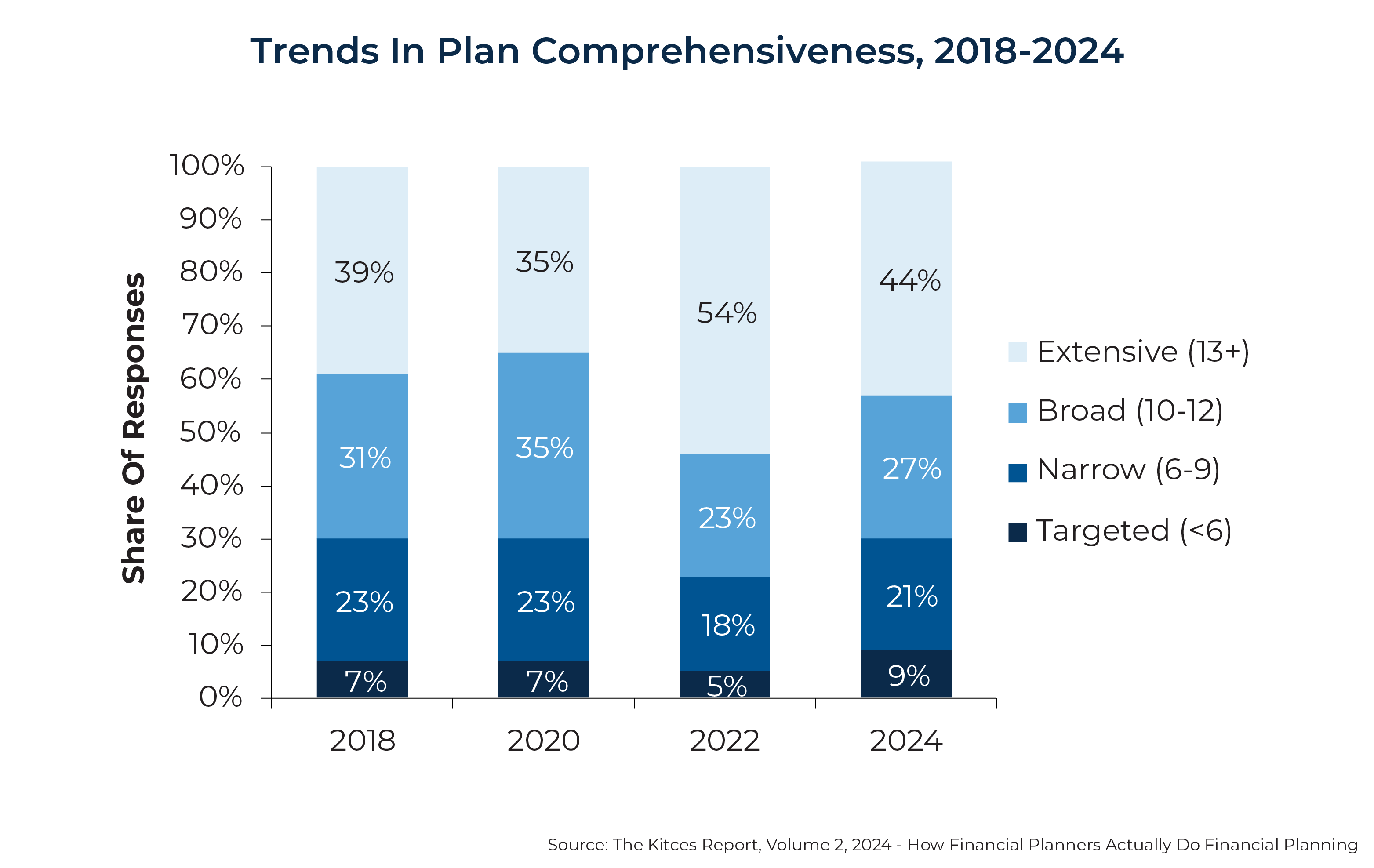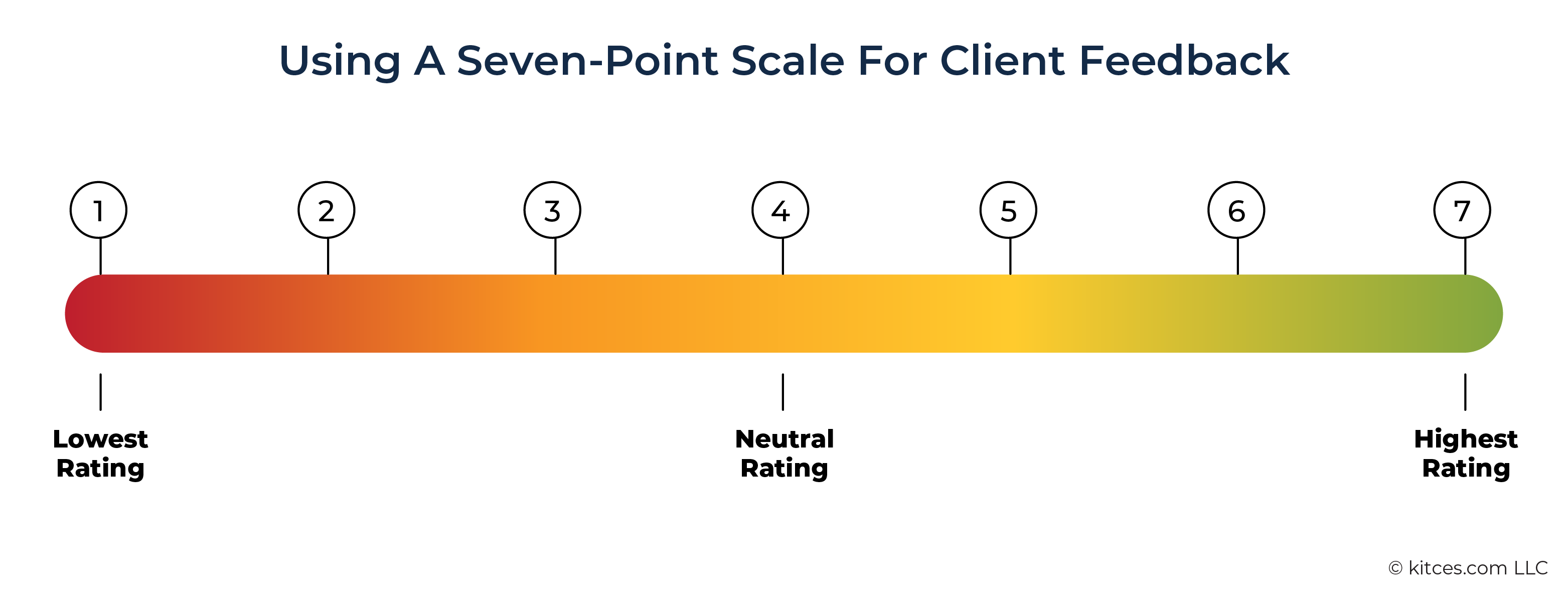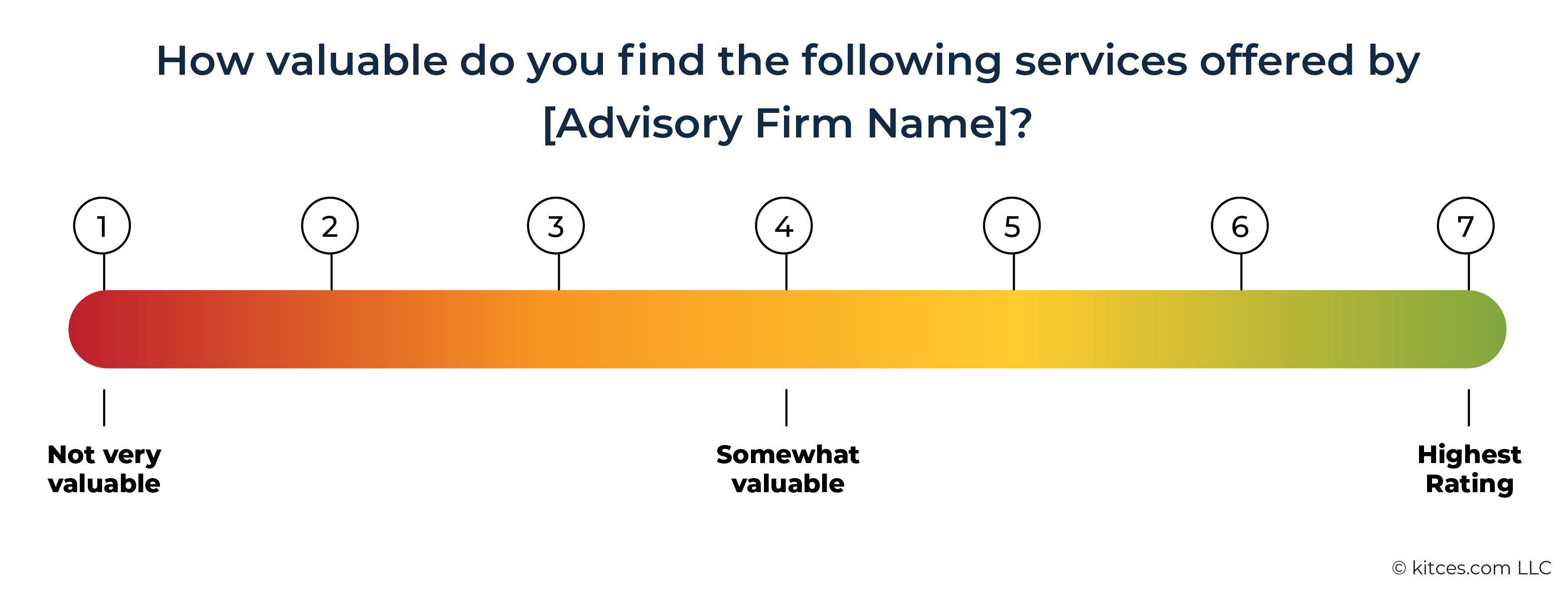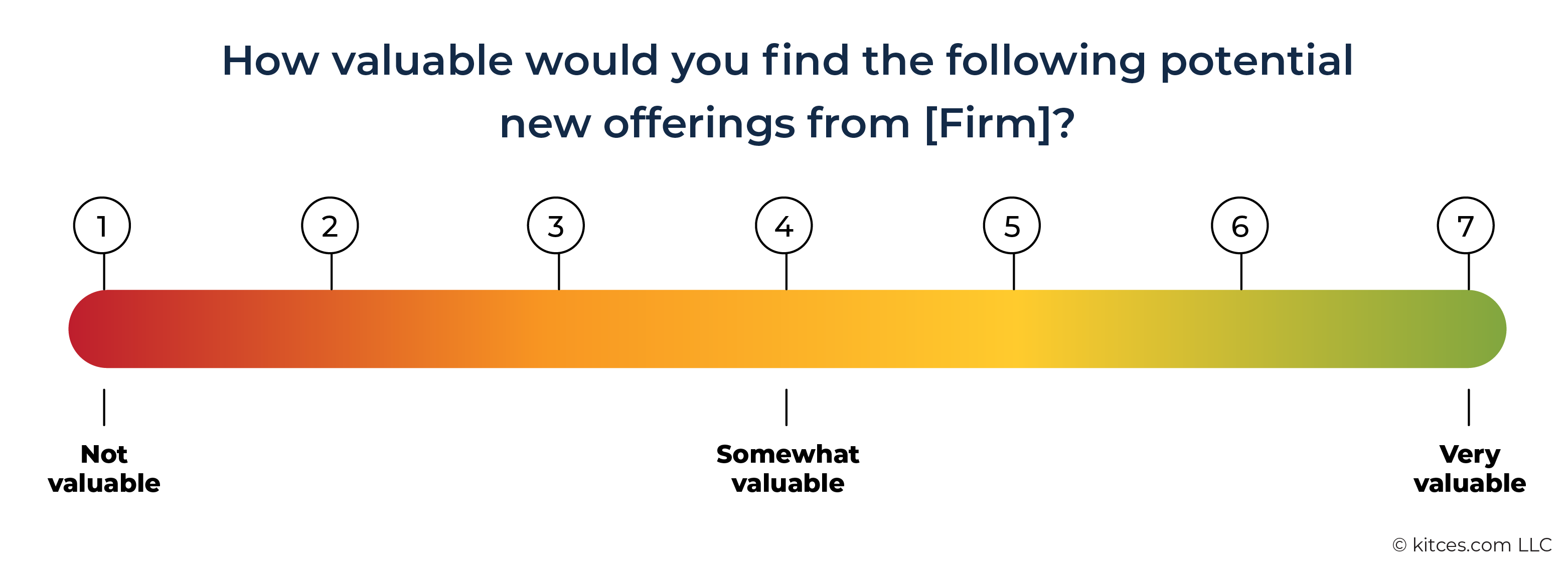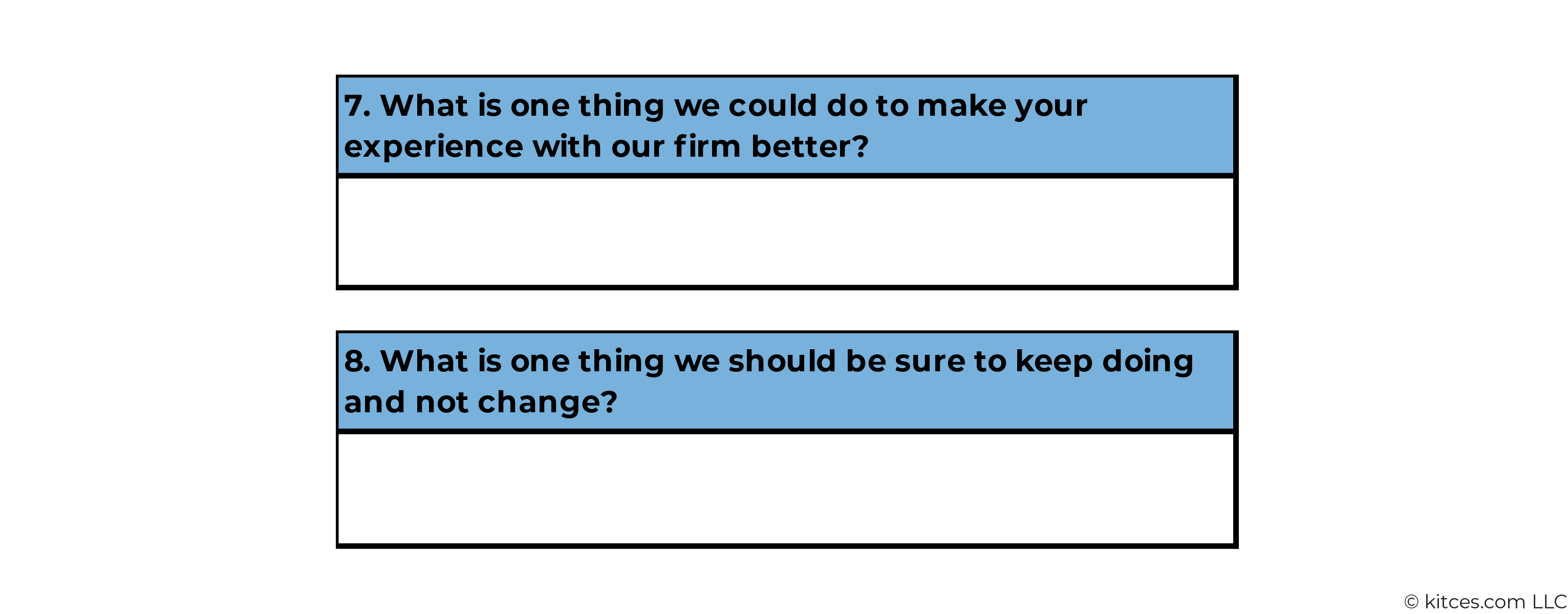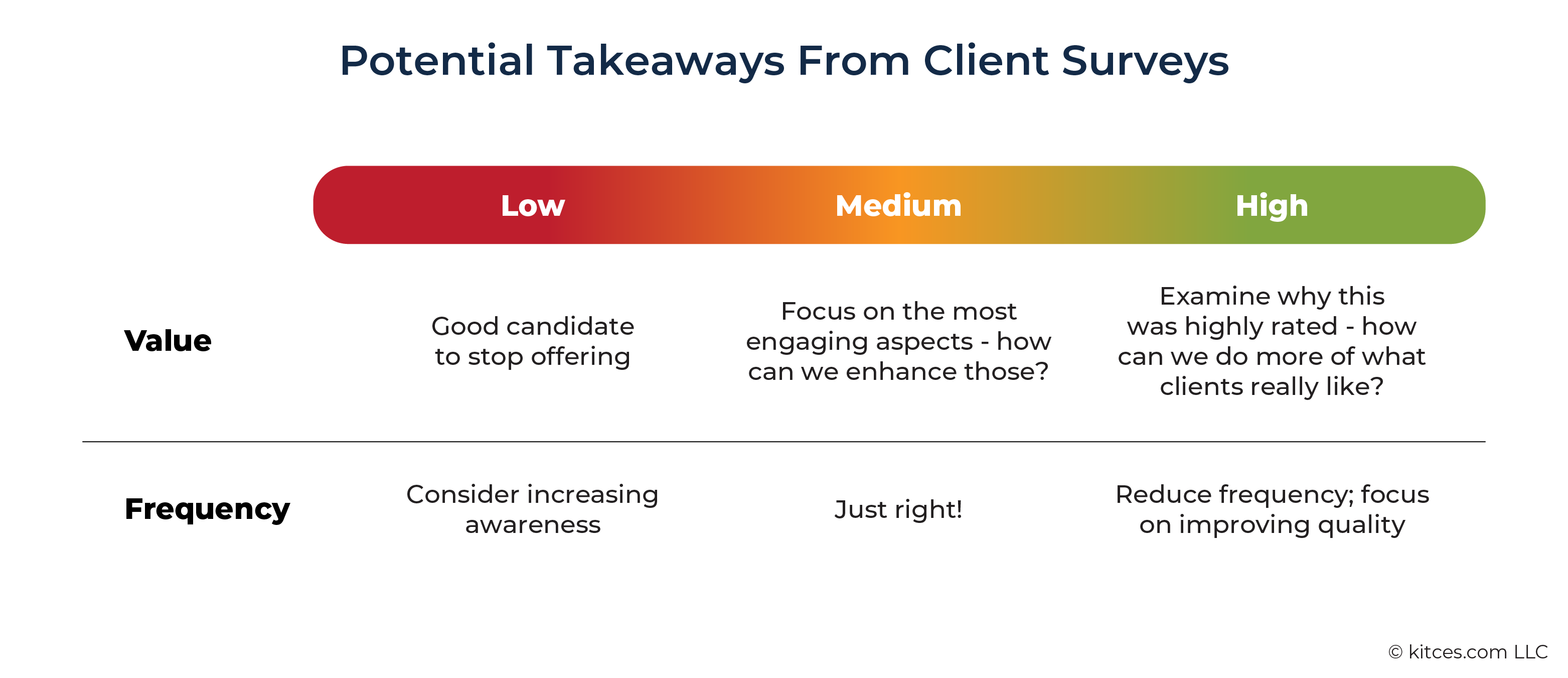Executive Summary
Financial advicers often market their comprehensive financial services as a way to differentiate themselves from other advisory firms and to stand out in the broader landscape of financial advice. These services may range from 'standard' offerings like retirement planning to less traditional areas like credit card consulting. In a firm's early years, there tends to be more room for experimentation, with advisors adding new services to provide value and attract clients. However, as a firm's capacity grows and its list of services expands, the focus often shifts – from asking how to do more for clients – to "How can I regain control of my time without reducing the value or quality of my services?"
The best roadmap for focusing an advisory firm will reflect how to do more of what clients value and scale back on what they don't use or appreciate. While advisors may make educated guesses about client preferences, this approach has its limits. Advisor often have different skills and perspectives than their clients (because if clients share the same inclinations, they might just be advisors themselves!), and it can be difficult to fully eliminate personal when evaluating clients' needs. One-on-one client calls can offer insights, but they're hard to scale and may unintentionally lead to biased responses.
A more efficient solution is an asynchronous client engagement survey, allowing clients to rate how much they value specific offerings. These surveys help advisors identify what to improve, what to reduce, and what to keep doing because clients enjoy it! Advisors can also gauge interest in potential future services, using that feedback as a compass for what to build next.
Beyond assessing service offerings, client engagement surveys provide advisors with an opportunity to gather feedback about other aspects of the business. Advisors can ask how much value clients feel they receive for their fees, how they perceive about the firm's overall responsiveness, and what the firm should stop or start doing. This detailed feedback can reveal unexpected insights into where clients are truly finding the most value!
In most cases, two weeks is enough time for the clients to complete the survey, with a few reminder emails sent while the survey is open. After the survey closes, advisors can evaluate the responses – what can they do more of? Where can they scale back? And which new business opportunities would clients value most? After some preliminary analysis, it's important to follow-up with clients, expressing appreciation and sharing at least one change the firm will make based on the survey results.
Ultimately, the key point is that client engagement surveys can be a powerful tool for advisors to identify what matters most to clients. They provide valuable insights not only on what to streamline but also on where clients are receiving the greatest value. Beyond improving efficiency, surveys demonstrate that the advisor values client input, strengthening relationships and enhancing satisfaction – which can lead to better retention and more referrals!
Can Comprehensive Service Be Too Comprehensive?
Financial advicers often market their comprehensive financial services as a way to differentiate themselves from both other advisory firms and the broader landscape of financial advice – such as robo-advisors, investment-only advisors, or insurance-focused advisors. 'Comprehensive' advice can encompass a wide range of services, from retirement, tax, and insurance planning to less traditional offerings like credit card consulting. In addition to these services, advisory firms frequently offer added value through events, newsletters, and, of course, continual touchpoints with clients as markets (and life) change!
Ideally, each component of comprehensive service forms part of the 'mosaic' of value that an advisor provides. Each touchpoint, plan update, and strategic service can enhance the client experience, improve retention, and increase the likelihood of client referrals. However, firms eventually hit a tipping point. Perhaps unsurprisingly, the same elements that drive expansion – larger teams, more affluent clients, and broader service offerings – also correlate with increased demands on an advisor's time, according to Kitces Research on How Financial Advisors Actually Do Financial Planning.
The latest Kitces Research on How Financial Planners Actually Do Financial Planning confirms this trend: The larger an advisory team and the higher the revenue per advisor, the more hours an advisor works. Furthermore, when firms employ CFP professionals, they tend to cover more components in their clients' financial plans, reflecting the broader expertise these professionals bring. This is illustrated in the graphic below, where solo advisors without CFPs cover a median of 14.5 components, whereas firms with multiple CFP professionals cover up to 19 components, significantly increasing the breadth of topics addressed.
While this increase in expertise allows firms to offer more, it also brings a new challenge: ensuring that the breadth of services aligns with what clients actually value.
Interestingly, despite the trend of increasing comprehensiveness, the recent 2024 Kitces Productivity survey shows a pullback in the number of components included in financial plans. In 2022, 54% of plans were classified as "Extensive", with 13+ components. However, by 2024, this number decreased to 44%.
This contraction suggests that firms are becoming more intentional about the services they offer, focusing on what truly matters to clients while managing the advisor's workload. Even as firms grow and add expertise (like CFP professionals), they may find that offering fewer, more targeted services can deliver greater impact, enhancing client satisfaction without overextending the advisor's time and resources.
This type of contraction may also be affiliated with a maturing business. In a firm's early years, there tends to be more room for experimentation, and advisors often focus on building additional services and offerings to provide value and grow their client base. However, as firms grow and their list of services expands, the challenge shifts. The question is no longer about how to do more for their clients, but how to regain control of their time – without reducing the value clients receive from the firm's services.
How Client Surveys Can Help Firms Enhance Their Service Offerings
This is where client surveys become invaluable. As firms adjust their range of services – whether they are expanding or contracting their offerings – surveys can be instrumental in identifying the components clients find most valuable… as well as with those that may no longer be necessary.
For example, a firm with multiple CFP professionals might have the ability to cover a wide range of complex topics. However, without understanding which services resonate most with clients, the firm risks overextending resources on components that don't significantly enhance client satisfaction.
By using surveys to align service offerings with client priorities, firms can maximize the impact of their expertise, regain control of their time while maintaining high-value relationships, and enhance client satisfaction without overburdening advisors.
Why To Ask Clients For Feedback At Scale (Instead Of Guessing)
It may be tempting to guess which services clients value, especially when certain offerings may seem excessively time-consuming or less rewarding for the advisor. Yet, while eliminating tasks might offer significant time and monetary savings, there's always the risk of cutting an offering that clients find truly valuable, whether it's a larger, intensive project like tax planning or smaller touchpoints like newsletters and regular check-ins. Furthermore, while there are always a few vocal clients who express their opinions, ascertaining how clients feel in the aggregate can be far more challenging.
There's a reason many businesses follow the Minimum Viable Product (MVP) approach: they build a basic version of a product, distribute it to the audience, and gather feedback to make improvements. Even when business owners try their best to anticipate the audience's needs and responses, understanding how services are perceived can be an inexact art and science.
Nerd Note:
Consensus bias, or the false consensus effect, is a cognitive bias where individuals assume that their own opinions and preferences are shared by the common populace. This can be especially relevant for financial advisors, who, in addition to the advantage of the technical training they receive, often have different personalities than their clients. The 2018 Kitces Research study on How Advisors Actually Do Financial Planning found that, on average, advisors are more extraverted, conscientious, and agreeable than the general population. Additionally, according to the 2021 Kitces Report On What Actually Contributes To Advisor Wellbeing, advisors also tend to be more goal-oriented.
This isn't necessarily a problem – advisors who are good at their jobs are expected to have different skills and perspectives than their clients (because if clients share the same personality traits, they might just be advisors themselves!). But it does mean that while the question "What would I want if I were my client?" can be a good starting point for brainstorming, it also risks introducing an advisor's own (very human) cognitive biases into the process.
As it turns out, a good way to determine what clients deem valuable is simple: just ask them. However, interviewing clients synchronously is not only time-consuming, but it's also easy to unconsciously change the questions for each client, which can lead to varying responses that are difficult to compare. Plus, unless meetings are meticulously recorded, it's easy to forget specific details of what was said!
Instead, advisors may opt to run an online survey distributed through an email list – which provides a time-efficient method to get a scalable portion of client feedback. Additionally, online surveys make it easy to ensure every client gets the same set of questions, making the feedback easier to analyze and compare.
Asking clients exactly what they like and value in an objective, scalable way can give advisors crucial information about what actually makes a difference for their clients. This information provides a clear roadmap for identifying which offerings to prioritize, which can be simplified, and which can be eliminated entirely.
Overcoming The Nerves That Accompany Asking For Feedback
While client surveys can be invaluable tools for improving firm operations, sending them out can be nerve-racking. Even when clients are paying for services, attending events, and appearing satisfied by all outward metrics, asking for feedback can be daunting – all the way up to (and even after) hitting 'send'.
On a practical level, setting firm (internal) deadlines for sending surveys can help push through this discomfort. Beyond that, keeping the bigger picture in mind is crucial: when used correctly, client surveys provide valuable insights that can guide the firm's growth. Constructive feedback, while sometimes hard to hear, is essential. If clients were deeply unhappy with just one key service…. wouldn't it be better to know sooner rather than later?
At the same time, many advisors who have implemented client surveys have been pleasantly surprised by the amount of positive feedback they receive. The advisor-client relationship is deeply personal, often entwined with many of a client's most significant life events, and clients often recognize and appreciate that connection. Good feedback can be saved as a morale booster on tough work days and can also highlight areas where advisors excel – offering clues about what they can continue doing more of. Meanwhile, constructive feedback plays an equally crucial role in identifying opportunities to improve the firm for prospects and clients alike!
General Principles For Success With Surveys
Most client survey questions can be structured using a rating scale, typically from 1 to 7, where 1 represents the lowest value, 4 indicates a neutral stance, and 7 reflects the highest value. Scaling questions can be a helpful way to get actionable data, and scoring on a scale of 7 can capture nuanced responses without overwhelming either the client or the advisor. For example, a 15-point scale may let clients get really specific about how they feel, but it may be difficult to differentiate between a 9 and an 11 on such a scale. Conversely, a 3-point scale can oversimplify responses, creating high levels of differences between each rating. The 7-point scale, though, is usually the sweet spot, offering enough detail to be insightful while remaining easy for clients to navigate.
When formatting questions, clarity is key. It's important to ensure clients understand exactly what they are supposed to rate. Some questions may ask about the value of firm offerings, while others ask about how clients feel about the frequency of firm offerings. Using formatting tools – such as bold, italics, and capitalization – can highlight key words and guide the client's understanding. For example, "How do you VALUE…" makes it clear that the question pertains to the perceived importance of a service rather than its frequency.
Another best practice is to ask only one question per question by limiting each question to a single focus. For example, asking, "How do you feel about the value and frequency of advisor meetings?" combines two different topics. A client may find meetings highly valuable but may also feel that three meetings a year are too frequent for their needs!
In terms of length, a good general guideline is to keep surveys to a maximum of 20 questions. According to Absolute Engagement, a firm specializing in client surveys for advisory firms, this typically means a client can expect to complete a survey in about 5–10 minutes. Briefer surveys may have a higher completion rate but may not give advisors as much depth or specificity as they'd like; longer surveys may have a lower completion rate.
Notably, the sample questions discussed below largely focus on a client's satisfaction with the firm's services – so questions on investment strategy are not included below.
Optional: To Ask For Names Or Not?
One common question that comes with designing client surveys is whether to ask for a client's name. After all, if clients are required to list their names alongside their feedback, they may be more reluctant to share their honest opinions. On the other hand, anonymous feedback can present its own challenges. If an anonymous survey response flags an easy-to-solve issue (e.g., not understanding how a certain feature works), it can be frustrating not to know who needs help. Of course, if multiple clients respond that they're not aware of a feature or are struggling with a product, that may signal a wider issue that needs addressing.)
Additionally, not every client may be an ideal fit for the firm, especially if the firm is in a transitional phase. For example, if a firm is halfway between transitioning into a different niche or toward serving larger clients, identifying who is providing the feedback can help advisors determine whether their services are resonating with their core clients. In cases where a firm is adjusting its strategy, some clients may naturally find less value in the firm's newer services as the business strategy changes.
That said, a good general principle is to allow space for respondents to list their names – but to make this response optional. This approach encourages honest feedback while giving clients the choice to identify themselves if they're comfortable doing so. Alternatively, advisors might use indirect questions to gauge client identity, such as "How long have you been with this advisory firm?" This can offer insights into the client's relationship with the firm without directly asking for personal information.
Core Questions To Ask In A Client Engagement Survey
Questions Of Value
How valuable do you find the following services offered by [Advisory Firm Name]?
Why ask? As financial planning firms grow, it's essential to check in on how clients actually feel about the firm's services. Surveys can lead with value-based questions about a range of offerings, such as meetings, educational events, year-end planning sessions, and specialized services such as tax planning. Additionally, this is a good opportunity to ask about the value that clients find in their client portal (or other technology tools), serving as a pulse check to ensure that the technology is useful!
In this case, a rating of '1' may indicate either that a client doesn't enjoy a service or that they don't use a service. A '4' signals indifference, while a '7' reflects high satisfaction. While low scores (e.g., 1s) might suggest that it's time to cease an offering, services with an average rating between 3 and 5 may offer an opportunity to improve or reimagine a service. It may be worth checking the open-ended comments (described later) to see if clients offer any suggestions.
Furthermore, if engagement metrics are available for highly rated events, it's worth checking to ensure that clients are also voting with their feet. In other words, while a client might like the idea of an event (and thus rate it highly), they may not actually attend the event. This, in turn, may merit further investigation – perhaps the event is being held at an inconvenient time or location, or maybe the topic selection needs to be improved.
How do you feel about the current pricing of fees relative to the value of the services [Advisory Firm] provides?
Why ask? How much to charge for financial advice is an ongoing conversation – charging too much may push away (too many) prospects, and charging too little can threaten the firm's profitability or sustainability.
Of course, ratings of '1' never feel good – especially since they may signal that a client is dissatisfied enough to consider leaving. However, if too many clients rate 7, it may be a signal that a firm is undercharging for their services and could benefit from 'right-sizing' their fees. A healthy range is often around a 5, indicating that clients feel they are receiving fair value without undervaluing the firm's services.
Questions Of Timing
How do you feel about the frequency of the following services offered by [Advisory Firm]?
Why ask? Frequency questions can be a great indicator of where a firm may be 'overservicing' clients – or where clients might be hungry for more!
The 'sweet spot' of frequency is a '4', signaling that the frequency feels just right. A '1' indicates the service is offered too infrequently, and a '7' suggests it's happening too often. Some offerings will have a place in both the value and frequency sections of the survey, which can provide a helpful cross-analysis. For instance, are clients rating webinars as highly valuable but feel that they happen too frequently? If so, how might the firm choose the very best webinars for clients? This approach can help firms design services that maintain their value without overwhelming clients.
Additionally, this is a good place to add an option for a client to note that they don't use a service, which is informative in itself, as it highlights which offerings may not be relevant to certain segments of the client base.
How would you rate [Firm]'s overall responsiveness?
Why ask? This question offers insight into the firm's capacity to meet client needs. If too many clients rate the firm's responsiveness as low, it may be an indicator that the team is stretched too thin – whether due to a growing client base or too many competing demands on the team's time. Alternatively, a low rating may also be an indicator that a process is broken and may suggest a need to look over the team's practices and procedures with fresh eyes.
On the other hand, high scores indicate high satisfaction – both to the quality and timeliness of responses. Kudos!
New Offerings
How valuable would you find the following potentially new offerings from [Firm]?
Why ask? It may be appropriate to add one or two questions gauging interest in potential new offerings. This is especially helpful when trying to assess how much clients would value a new idea, saving time and resources by testing concepts early. Because it's much cheaper to write a sentence describing a hunch than to build an entire offering only to find limited interest!
That being said, even if a new offering is highly rated, it's important to continue following up with careful planning and testing to ensure that clients not only express interest but also engage with the service once it's introduced. High survey ratings are a strong indicator, but true validation comes when clients also vote with their feet!
The "One Thing" Approach
What is one thing we could do to make your experience with our firm better?
What is one thing we should be sure to keep doing and not change?
Why ask? Both of these questions can be formatted to accommodate open-ended answers, giving clients the opportunity to share their full thoughts. Asking for 'just' one thing simplifies the feedback process and can help a client offer actionable feedback. Asking questions like "What would make your experience better?" can feel too large and may elicit vague responses like "Just keep doing what you're doing!" that don't offer specific insights for improvement(though at least they feel nice!). By narrowing the focus and asking for only one thing narrows the 'scale' of the question and makes it easier to write a response that the advisor can directly act on!
Additionally, the "What one thing should we keep doing" question gives valuable insight into what clients really value – whether it's the team itself, a particular service offering or format, or the firm's responsiveness. Understanding what clients value most helps ensure that key strengths are preserved, even as other areas evolve.
Bringing It All Together
A complete template that brings all the questions discussed has been provided as a customizable survey formatted with a 1 to 7 rating scale for easy client responses. The document also includes the email templates discussed later and can be accessed here as a downloadable Word document. Fields marked with square brackets should be customized with the firm's name and relevant information. Additional adjustments may be needed to tailor the survey to the firm's unique offerings and client base before distribution.
How To Execute A Client Survey
With the survey questions written and finalized, advisors can begin the next step of building the survey in an appropriate platform.
There are many different survey providers available. Current technology solutions that are designed specifically for the advisory space include Absolute Engagement, Nexa Insights, and Practice Intel. These tools all allow advisors to build their own surveys, provide templates based on desired metrics, and offer a wealth of data insights into the client/advisor relationship – such as assessing relationship quality and estimating a client’s likelihood to provide referrals.
For advisors looking for a survey with robust and specific industry knowledge, these tools may be a strong fit. Many also offer benchmarking options, enabling firms to track their relative performance year over year.
Alternatively, firms already using Google or Microsoft services may find Google Forms or Microsoft Forms to be excellent starting points due to their ease of integration and familiarity. Airtable is another flexible option for surveys, though it may take some additional effort to format the interface for optimal survey results. SurveyMonkey is another well-known survey tool with traditional features but comes at a higher price point. Qualtrics delivers robust survey capabilities, including a free version with limited options, though its extensive features may exceed what advisors may need for a straightforward client survey.
Once the survey software is selected, advisors should upload and review questions carefully. Before distributing the survey, it's essential to test it a few times to catch any issues – whether technical glitches or awkwardly worded phrases. After all, adjusting wording partway through a survey can change how clients respond!
Whenever possible, have at least two people review and test the survey before it's sent out. This additional layer of feedback can help identify unclear questions or formatting issues that might otherwise go unnoticed.
Distributing The Survey To Clients
When a survey is ready to go, the next step is to distribute it to clients – typically via email. Use language that explains the why behind the survey to clients – as well as what the clients themselves will stand to gain in the long term. (Better service! New, more relevant offerings!) Clients are more likely to engage when they understand the direct impact of their input—whether it leads to better service, more relevant offerings, or improved communication.
Additionally, set clear expectations – most crucially, how long the survey is likely to take and what date the survey will close. Allowing for two weeks is generally plenty of time! And, of course (speaking as a person who often forgets to include email attachments) – be sure to include the survey link at the end of the email!
An initial email may read something like this:
Title: Your Input Requested: Client Survey
Dear [Name],
I'm excited to announce our first client survey goes live today! You can have a voice in the future of [Firm] – tell us what you would like to see more of, weigh in on future offerings, and let us know where else we can improve your experience!
The survey has [7] questions and should take about [5] minutes to complete. The survey is open until [date].
Thank you in advance for your time. Your honest thoughts will help [Firm] serve you even better!
[Link to survey]
Sincerely,
[Your Name]
After the initial survey invitation is sent, it's important to follow up to maximize participation. When there are just a few days left before the survey closes, send a follow-up email to remind clients of the survey, reiterate the deadline and purpose, and include the survey link again for easy access.
Title: Last Chance: Tell Us How We Can Better Serve You!
Dear [Name],
This is a friendly reminder that our survey closes on [Date]. We would love to have your feedback on your experience with [Firm] – what we're doing well and what new services we could offer to better serve you in the future.
The survey consists of just [7] questions and will only take a couple of minutes to complete. Your honest feedback is invaluable to us, and we greatly appreciate you taking the time to share your thoughts!
[Link to survey]
Sincerely,
[Your Name]
A 20–30% rate response from clients is a good target to aim for, providing enough data to analyze trends across the firm's client base. For larger firms, a 5–10% rate may be more realistic and still yield meaningful insights.
Making The Most Of Survey Results
After the survey has closed, take some time to look over the results in the software. Resist the impulse to filter responses immediately – instead, start by observing the raw data. On a notepad or in a document, record initial observations:
- Were there any unexpected results?
- Which services received exceptionally high (or low) ratings?
- Are there offerings that clients seem unaware of?
- Do any patterns emerge from the 'one thing' responses?
- If clients included their names, are there any issues that need to be solved with individual clients?
Next, read over the open-ended responses to identify recurring themes. If there are a large number of them, consider using an analytics tool or AI software (such as ChatGPT) to help categorize feedback and surface key trends.
Finally, experiment with filtering responses based on different parameters. This can provide interesting ways to uncover a multitude of trends and insights within specific client groups.
For example:
- How do clients who attend all of our events feel about the frequency of touchpoints and meetings?
- Do newer clients rate services differently from long-term clients?
After reviewing the raw data and exploring different filters, the next step is to interpret the results and consider actionable next steps.
Low-value ratings don't necessarily signal dissatisfaction – they could simply indicate a lower level of awareness. While some of this may be confirmed in open-ended responses, advisors may also consider evaluating their messaging and marketing strategies as part of their review process to ensure clients fully understand the services offered. Ultimately, though, if awareness is not the issue and few clients are using a service, it may be a good indicator of something to eliminate.
When offerings are rated as valuable but too frequent, this suggests an opportunity to scale back rather than remove the service entirely. Reviewing engagement rates (e.g., RSVP rates or actual meeting/event attendance) can help differentiate between offerings that are most valuable to clients and those that might be overwhelming. For example, if year-end tax planning webinars are consistently well attended but estate planning webinars see lower participation, this may indicate where adjustments can be made to better align with client interests.
Finally, offerings that are evaluated as highly valuable can represent more than just opportunities to continue successful offerings – they can also serve as powerful marketing tools. Highlighting highly rated services on the firm's website or in promotional materials not only reinforces the firm's strengths but also helps attract prospective clients by showcasing what sets the firm apart.
Sharing Results And Takeaways With Clients
After analyzing the survey results, it's important to share key takeaways with clients. While not every detail needs to be disclosed, voicing appreciation for their participation, affirming what services will be kept, and giving some indicators of upcoming changes can go a long way. This not only helps clients feel heard, but also affirms that their feedback in these surveys has a real impact on the firm – encouraging more participation in future surveys!
Title: Changes To [X] And Client Survey Results!
Dear [Name],
Thank you to everyone who participated in our recent client survey. Your feedback was truly invaluable, and we are so grateful to everyone who took the time to share their thoughts.
While there are more changes based on the survey still to come, we're excited to announce that, as a direct result of your feedback, we will be [changing/enhancing/reformatting] [specific offering], starting around [date].
Thank you again to everyone who participated. We look forward to continuing to build a firm that better serves each of you!
Sincerely,
[Your Name]
Providing thoughtful follow-up communication is key to reinforcing the value of client feedback. To help streamline this process, all of the email templates included here have been provided in a Word document, which can be downloaded here. These templates can be adapted to fit different stages of the survey process, from initial invitations to sharing results and announcing new offerings.
Nerd Note:
The key point is that client surveys can provide an excellent way to gather meaningful client feedback. And by understanding what clients truly value – and where there's room for improvement – advisors can refine their offerings to better align with client needs. This not only enhances client satisfaction and retention but also helps streamline operations, ensuring time and resources are focused on the services that make the greatest impact.
In the long run, leveraging client feedback can transform an advisory firm's growth strategy, promoting deeper relationships with existing clients while attracting new ones who resonate with the firm's evolving value proposition. Ultimately, surveys aren't just a tool for improvement—they're a powerful way to stay connected, responsive, and aligned with what matters most to clients!



